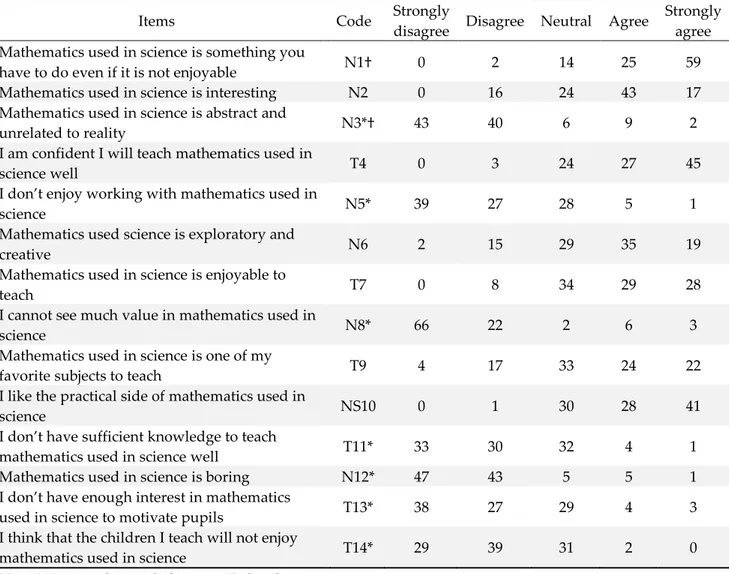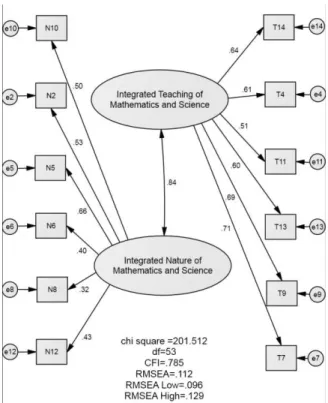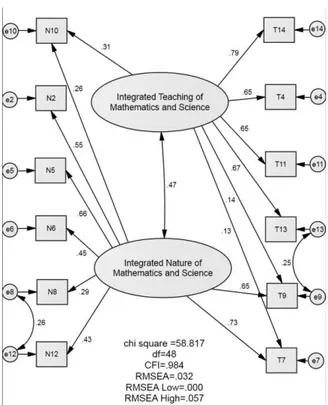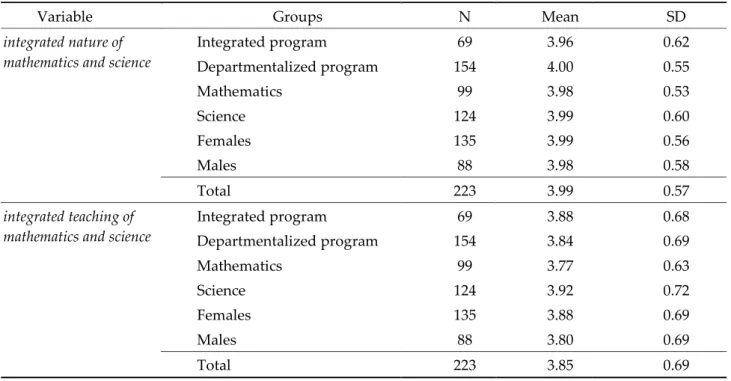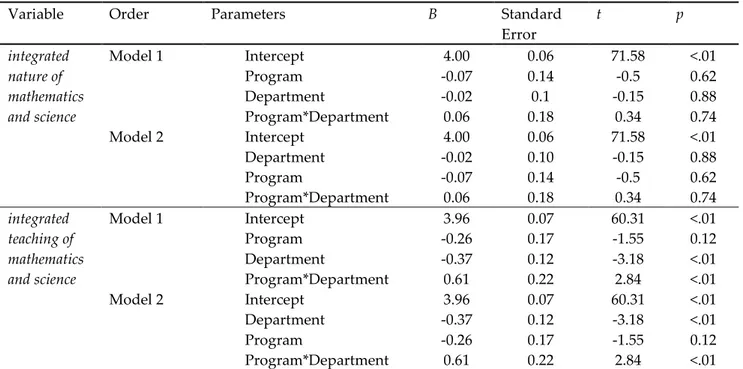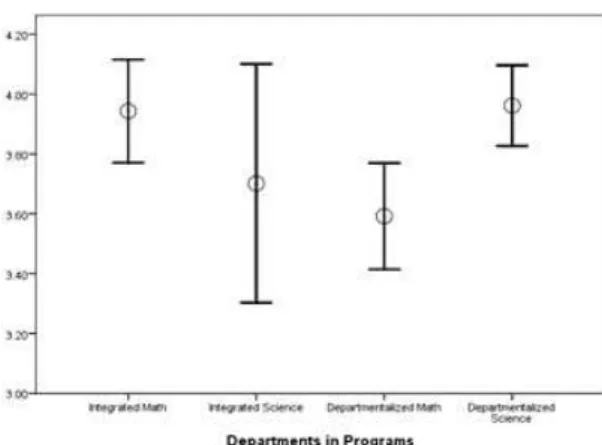www.iojes.net
I
nternational
O
nline
J
ournal of
E
ducational
S
ciences
ISSN: 1309-2707
Investigating the Mental Readiness of Pre-Service Teachers for Integrated
Teaching
M. Sencer Corlu
1, Robert M. Capraro
2M. Ali Çorlu
31Bilkent University 2Texas A&M University 3Istanbul Commerce University
A R TIC LE I N F O A BS T RA C T
Article History: Received 29.06.2014 Received in revised form 11.01.2014
Accepted 25.11.2014 Available online 01.03.2015
There has been some criticism of the teacher education programs in Turkey, claiming that pre-service teachers were not ready for the profession. This study explored the mental readiness of pre-service teachers to facilitate integrated mathematics and science. Data were collected from pre-service teachers who were enrolled in either integrated or departmentalized teacher education programs. Data were analyzed using a three-way multivariate factorial analysis of variance model. The independent variables were program (integrated or departmentalized), department (mathematics or science), and gender while the dependent variables were the attitudes towards the integrated teaching and nature of mathematics and science. The results indicated that pre-service mathematics teachers in the integrated teacher education program had more favorable attitudes towards integrated teaching of mathematics than pre-service mathematics teachers in the departmentalized program. The study showed that the integrated program may be an effective alternative to the standard departmentalized teacher education programs in Turkey.
© 2015 IOJES. All rights reserved
Keywords: 1
Teacher Education Curriculum, Mathematics Education, Pre-service Teacher Education, Student Teachers’ “ttitudes, Integrated Mathematics and Science, Teacher Education in Turkey
Introduction
The Turkish political leadership’s vision was to develop a competitive country in the st century. To accomplish this, the political leadership developed the Vision 2023 foresight document and charged policy making organizations to enact legislations that would increase the size and productivity of the innovative human capital of the nation (Serbest, 2005). Both Ministry of National Education (MoNE), K-12 policy maker, and Council of Higher Education (CoHE), higher education policy maker, independently developed strategies to improve mathematics and science education in the country. However, reforms at K-12 and higher education levels were enacted with little coordination between policy making organizations. For example, MoNE changed the middle grades (fourth through eighth grade) standards and encouraged mathematics and science education teachers to integrate their subjects (MoNE, 2009a, 2009b, 2013a, 2013b) after CoHE abandoned the double certification program for middle grades mathematics and science pre-service teachers, which was enabling them to graduate with a minor degree in the other subject. During this
period of double certification, CoHE’s pre-service teacher education program required no coursework to
foster integrated teaching knowledge (Corlu, 2014) and few courses in pre-service teachers’ minor teaching area. When the new program was introduced, it became apparent that the new program was even more theory (content or pedagogy) intensive than the old program (Bulut, 2007; Kartal, 2011). Because CoHE recommended it, almost all universities adopted this teacher education program with minor modifications (Isiksal & Cakiroglu, 2006).
1 Correspondence should be directed to M. Sencer Corlu, Graduate School of Education, Bilkent University, Ankara-Turkey. Phone: +90 312 2903432
e–mail: sencer.corlu@bilkent.edu.tr
The uncoordinated strategies of MoNE and CoHE limited the impact of the reforms in twofold. First, according to the Trends in International Mathematics and Science Study (TIMSS) and Programme for International Student Assessment (PISA), Turkish students continued to underperform peers (Alacaci & Erbas, 2010; Organisation for Economic Co-operation and Development [OECD], 2009b). Second, according to the Teaching and Learning International Survey (TALIS), the need for quality teachers continued to be a major problem (OECD, 2009a). In response to discouraging findings in cross-national studies, several influential organizations in the country, such as Scientific and Technological Research Council of Turkey (2010) and Turkish Academy of Sciences (2010) called policy making organizations to coordinate their efforts and increase access to Science, Technology, Engineering, and Mathematics (STEM) education by developing effective teacher education programs. The uncoordinated reform approaches in K-12 and teacher education levels failed to produce effective outcomes.
Attitudes towards Mathematics and Science
Researchers described the attitude concept in regard to two related theories. The theory of planned behavior, which was an extension of theory of reasoned action (Fishbein & Ajzen, 1975), posited that if individuals evaluated the suggested behavior (attitude) as positive and if they thought they were expected to perform the behavior then they would increase their motivation, which would result in an intention to perform that suggested behavior (Ajzen, 1985, 1988). In both theories, attitude was a concept of belief that represented a person’s general feeling of favorableness or unfavorableness toward some stimulus object
(Fishbein & Ajzen, , p. . ”ecause teacher beliefs were tacit, often unconsciously held assumptions
about students, classrooms, and the academic material to be taught Kagan, , p. , attitudes of
teachers was defined as a mental state of readiness, which was organized through experience (Kulm, 1980). In fact, some researchers added that attitudes towards a discipline were usually defined by the instruments used in the study (Aiken, 1970).
The attitudes of mathematics and science teachers have been investigated in a number of studies. Researchers stated that poor attitudes of pre-service teachers towards mathematics or science might inhibit both their own learning and teaching their subject area (Battista, 1986; Czerniak & Chiarelott, 1990). Research also showed that teachers’ negative attitudes towards mathematics might be transmitted to students Larson,
or might negatively affect their students’ mathematics achievement Schofield, . Earlier research
on teachers’ attitudes towards mathematics indicated that attitude had a statistically significant relationship with student achievement despite little practical significance (Aiken, 1976; Pajares, 1992). A mean effect size Cohen’s d = 0.12) is estimated across more recent studies on mathematics attitude and achievement (Ma & Kishor, 1997). In Turkey, it was shown that there was no statistically significant difference between male and female pre-service teachers’ attitudes towards science (Bayraktar, 2011; Bilgin & Geban, 2004; Tekbiyik & Ipek, 2007; Turkmen, 2002; Ucar & Sanalan, 2011). In one of the recent studies, researchers found that at the end of their four-year pre-service teacher education program, Turkish science teachers attitudes towards science was statistically significantly less than their attitudes at the beginning Cohen’s d = 0.60) (Bayraktar, . In another study, CoHE’s new pre-service teacher education program did not improve pre-service teachers’ attitudes towards science (Ucar & Sanalan, 2011).
Several researchers in the U.S. concluded that the attitudes of in-service teachers towards mathematics and science integration were statistically significantly lower than pre-service teachers’ attitudes. “ possible explanation to this finding was the subject-matter oriented teacher education of the past compared to the pedagogical content knowledge emphasis in the current pre-service teacher education programs in the U.S. (Lehman, 1994; Pang & Good, 2000; Stevens & Wenner, 1996). However, research also indicated that teachers’ positive attitudes towards the integrated nature of mathematics and science did not automatically transfer into a successful implementation of integrated curriculum (Wicklein & Schell, 1995).
In qualitative investigations of attitudes of pre-service teachers’ towards the integrated nature of mathematics and science, researchers found that integrated teacher education programs enhanced pre-service teachers’ understanding of integration and at the end of the program they were able to recognize and appreciate integrated mathematics and science applications (Koirala & Bowman, 2003; Morrison & Roth-McDuffie, 2009). In another similar study, an integrated pre-service teacher education program was found to
be an effective way to help mathematics and science pre-service teachers recognize the complexity and challenges of STEM education teaching (Berlin & White, 2010).
Research Constructs and Questions
STEM education is conceptually defined as the set of knowledge, skills and beliefs which are collaboratively constructed [by students and teachers] at the intersection of more than one STEM subject
area Corlu, Capraro, & Capraro, , p. . Similarly, a positive attitude towards STEM education is
described as a mental state of readiness to construct knowledge at the intersection of more than one STEM subject area. Dogan (1999) suggested that when exploring the attitudes of pre-service teachers, it was necessary to consider their attitudes towards both the nature and teaching of the subject area. Several examples of STEM education with respect to mathematics used in science exist in the curriculum, including using probability in Punnett squares, reading graphs in time-velocity-displacement, or checking relations among quantities through dimensional analysis. Thus, in this paper, we limited our definition of mental readiness towards STEM education to the attitudes towards mathematics and science integration.
The purpose of this study is to describe the mental readiness of pre-service teachers for STEM education in terms of their attitudes towards integrated nature and teaching of mathematics and science. The specific research questions were: (a) Are the attitudes of teachers studying in an integrated teacher education program more favorable than teachers studying in a departmentalized teacher education program? (b) Are the attitudes of teachers affected by any interaction of program (integrated or departmentalized), department (mathematics or science), and gender main effects?
Methods Participants
The sample for this study was purposively drawn from pre-service mathematics and science teachers who were studying at state universities (university A or university B). Both universities were located in a major metropolitan city in Turkey. Participants were in the last semester of their 4-year undergraduate program, planning to graduate as school teachers with middle grades specialization (fourth through eighth grade). Further, the participants in the sample met two criteria: (a) they were eligible to graduate at the end of the term; (b) they were enrolled in their last methods courses.
The total sample size was 226: university A mathematics = 50 (Female = 25), university A science = 19 (Female = 12), university B mathematics = 49 (Female = 24), and university B science = 108 (Female = 75). The mean age of the participants across groups were similar (Mean = 22.27; SD = 0.43). The methods course instructors awarded trivial extra credit to participants and the response rate was above 80%. Researchers acquired the approval of the institutional review board before data collection.
Program Comparison
Pre-service teacher education departments at university A (integrated mathematics or integrated science program) and university B (departmentalized mathematics or departmentalized science program) accepted students who were ranked in the fifth percentile or above of one and a half million high school graduates (Student Selection and Placement Center, 2007). There were three major differences between the universities:
1. At university A, the integrated program required a balanced coursework in theory (pedagogy and content) and practice (pedagogical content knowledge and integrated teaching courses). At university B, departmentalized programs were theory intensive;
2. at university A, the integrated program required more content courses in pre-service teachers’ minor teaching area (mathematics or science) than departmentalized programs at university B; 3. at university A, integrated program allowed pre-service teachers in both departments to take
courses together while at university B departmentalized programs required pre-service teachers to take all their courses separately.
Although the two departments in the integrated program at university A were very similar in terms of distribution of coursework, at university B pre-service mathematics teachers were required to take relatively
less pedagogical content knowledge courses in their major teaching area than pre-service science teachers.
Earlier research showed that CoHE’s standard program was similarly theory-intensive and similar to
university B program (Ucar & Sanalan, 2011).
Data Collection
The data collection instrument adapted items from Dogan’s (1999) attitude survey, which was selected for four reasons: (a) items were developed with a consideration of other widely-used surveys, either in attitudes towards mathematics or science (e.g., Aiken, 1970, 1976; Schonfeld, 1989); (b) Dogan developed items with a consideration of mathematics and science curriculum in Turkey; (c) items were specifically designed in Turkish and for Turkish pre-service teachers; (d) score reliability in a similar context to the current study was reported at an acceptable level Cronbach’s alpha = 0.76 for N = 344).
The instrument used in the current study included seven negatively and seven positively worded items in addition to the definition and several examples to ensure that there was a similar understanding between the researcher and the participants. The integrated nature and teaching of mathematics and science was defined as particular products of STEM education that allows teachers to teach mathematics used in science.
The instrument was administered online and participants were allowed to complete the survey anytime in a 24-hour period at their convenience. To ensure there were no missing data, online survey used item validation, which required pre-service teachers to respond to each item. To ensure participant answers were not random, their completion time was monitored. Mean completion time was 4.5 minutes (SD = 1.8 minutes). There were no outliers in terms of completion time. See Table 1 for the items included in the instrument and percentages of responses for each item.
Table 1. Percentages of responses for each item
Items Code Strongly
disagree Disagree Neutral Agree
Strongly agree Mathematics used in science is something you
have to do even if it is not enjoyable N † 0 2 14 25 59
Mathematics used in science is interesting N2 0 16 24 43 17
Mathematics used in science is abstract and
unrelated to reality N *† 43 40 6 9 2
I am confident I will teach mathematics used in
science well T4 0 3 24 27 45
I don’t enjoy working with mathematics used in
science N5* 39 27 28 5 1
Mathematics used science is exploratory and
creative N6 2 15 29 35 19
Mathematics used in science is enjoyable to
teach T7 0 8 34 29 28
I cannot see much value in mathematics used in
science N8* 66 22 2 6 3
Mathematics used in science is one of my
favorite subjects to teach T9 4 17 33 24 22
I like the practical side of mathematics used in
science NS10 0 1 30 28 41
I don’t have sufficient knowledge to teach
mathematics used in science well T11* 33 30 32 4 1
Mathematics used in science is boring N12* 47 43 5 5 1
I don’t have enough interest in mathematics
used in science to motivate pupils T13* 38 27 29 4 3
I think that the children I teach will not enjoy
mathematics used in science T14* 29 39 31 2 0
Validity
Score reliability was acceptable for both factors: integrated nature of mathematics and science
Cronbach’s alpha = . with items and integrated teaching of mathematics and science Cronbach’s alpha
= .80) with 6 items (Nunnally, 1978). Corrected item-total correlations were below the 0.3 threshold (Pallant, 2001) for two items (N1 and N3). Both items were dropped from the instrument. Inter-tem correlations for integrated nature of mathematics and science (mean = .23; range = .07 - .35) and integrated teaching of mathematics and science (Mean = .41; range = .22 - .58) indicated both measures were broad constructs of attitudes (Clark & Watson, 1995).
A confirmatory factor analysis of the remaining 12 items on two factors was conducted using structural equation modeling (SEM) with Analysis of Moment Structures (AMOS) software (Arbuckle & Wothke, 1999) (See Figure 1 for the default model). The numbers by the arrows from the latent variables to observed variables are standardized factor loadings. Several fit indices are also shown on the figure, including
statistically significant χ = . p < .001) with df = 53, comparative fit index (CFI) = .785, and root mean
square error of approximation (RMSEA) = .112.
Figure 1. Initial confirmatory factor analysis model.
Investigating the modification indices for a better model fit lead to the revision of the default model. All standardized regression weights in the revised model (See Figure 2) were statistically significant (p < .01), except for items T7 and T9. Both items were rather unreliable predictors of scores. A necessity to reword T7 and T9 emerged as their factor score weights for integrated nature of mathematics and science were greater than their factor score weights for integrated teaching of mathematics and science. The other modifications from the default model were theory-driven: (1) N8 (I cannot see much value in mathematics used in science) and N12 (mathematics used in science is boring) error correlation was based on earlier research, associating mystery-level values with the nature of mathematics and science (Bishop, 2008). Hence, it might be the case that pre-service teachers evaluated the abstract nature of mathematics as boring. The errors of T I don’t have enough interest in mathematics used science to motivate pupils) and T9 (mathematics used in science is one of my favorite subjects to teach were correlated with the theoretical support from Dweck and Leggett’s (1998) model, explaining the relationship between interest and motivation.
Figure 2. Revised confirmatory factor analysis model.
The sample size was considered large enough to yield robust estimates. In addition, all univariate distributions were evaluated to be normal with respect to the absolute values of skewness and kurtosis Kline, . Several fit indices were used for the model a χ = . failed to provide a statistically significant value with p = .14 (Barrett, 2007); (b) CFI equals .98 was particularly a good evaluator of model fit (Tabachnick & Fidell, 2007) given that threshold value of CFI should be above .95; (c) a maximum value of .06 was also met for the RMSEA = .03 in the model (Hu & Bentler, 1999). The model reflected an acceptable or excellent fit to data.
Analysis
The data were first examined with respect to univariate normality, Mahalanobis distances for multivariate normality, homogeneity of error variance, and equality of covariance matrices. Assumptions were checked by means of graphical and descriptive statistical measures, such as histogram, scatter-plots, skewness, and kurtosis (Tabachnick & Fidell, 2007). Three outliers were detected and excluded from further analyses. Data were analyzed with a three-way multivariate Analysis of Variance (ANOVA) model with continuous dependent variables; integrated nature of mathematics and science and integrated teaching of mathematics and science scores (ranged 1-5) and nominal independent variables gender (female = 0, male = 1), department (mathematics = 0, science = 1), and program (integrated = 0, departmentalized = 1).
Results
Table 2 shows the descriptive statistics for continuous variables: integrated nature of mathematics and
Table 2. Descriptive statistics of scores for each group
Variable Groups N Mean SD
integrated nature of mathematics and science
Integrated program 69 3.96 0.62 Departmentalized program 154 4.00 0.55 Mathematics 99 3.98 0.53 Science 124 3.99 0.60 Females 135 3.99 0.56 Males 88 3.98 0.58 Total 223 3.99 0.57 integrated teaching of mathematics and science
Integrated program 69 3.88 0.68 Departmentalized program 154 3.84 0.69 Mathematics 99 3.77 0.63 Science 124 3.92 0.72 Females 135 3.88 0.69 Males 88 3.80 0.69 Total 223 3.85 0.69
Pearson’s r product moment correlation coefficient between the integrated nature of mathematics and science and integrated teaching of mathematics and science scores was statistically significant (r = .53, p < .01), indicating a moderate correlation between dependent variables (Tabachnick & Fidell, 2007).
In three-way multivariate ANOVA, the equality of covariance matrices test was not statistically significant, ”ox’s M = 17.72, F (21, 12140.75) = 0.80, p = .72. Sum of squares was partitioned with Type I method sequentially in the gender, program, department, then gender by program, gender by department, department by program, and finally gender by department by program order. The uncontrolled main effect of gender was not statistically significant, Wilks’ λ = 1, F (2, 214) = 0.50, p = .61, partial η2 = 0.005. Observed power for effects that were not statistically significant were gender (13%), program (11%), department (48%), program by gender (38%), department by gender (40%), and program by department by gender (15%). The three-way multivariate ANOVA model explained only 2.4% of the variance in the integrated nature of mathematics and science scores, R2 = .02 (adjusted R2 = -.01), and 6% of the variance in the integrated teaching of mathematics and science scores, R2 = .06 (adjusted R2 = .3). Thus, analysis showed that gender was not a statistically significant predictor of pre-service teachers’ scores, three-factor term was dropped, and two-factor model was tested.
Table 3. Parameter estimates for two-way multivariate ANOVA
Variable Order Parameters B Standard
Error t p integrated nature of mathematics and science Model 1 Intercept 4.00 0.06 71.58 <.01 Program -0.07 0.14 -0.5 0.62 Department -0.02 0.1 -0.15 0.88 Program*Department 0.06 0.18 0.34 0.74 Model 2 Intercept 4.00 0.06 71.58 <.01 Department -0.02 0.10 -0.15 0.88 Program -0.07 0.14 -0.5 0.62 Program*Department 0.06 0.18 0.34 0.74 integrated teaching of mathematics and science Model 1 Intercept 3.96 0.07 60.31 <.01 Program -0.26 0.17 -1.55 0.12 Department -0.37 0.12 -3.18 <.01 Program*Department 0.61 0.22 2.84 <.01 Model 2 Intercept 3.96 0.07 60.31 <.01 Department -0.37 0.12 -3.18 <.01 Program -0.26 0.17 -1.55 0.12 Program*Department 0.61 0.22 2.84 <.01
Note: Departmentalized program and science department were the reference cells in the intercept.
Table 3 shows the parameter estimates for two-way multivariate ANOVA. In two-way multivariate “NOV“ with department and program factors, equality of covariance matrices ”ox’s M or Levene’s homogeneity of variance tests for both factors were not statistically significant. Neither in model 1 (program, department, and program by department order) nor in model 2 (department, program, and program by department order) was there any statistically significant effect of the factors, except for the interaction of program by department was statistically significant for the integrated teaching of mathematics and science scale, Wilks’ λ = 0.96, F (2, 218) = 5.04, p < 0.01.
When the interaction was investigated for each factor, it was statistically significant for integrated teaching of mathematics and science, F (1, 219) = 8.05, p < .001, η2 = 0.03, Mean Square Error = 0.45. Pre-service mathematics teachers in the departmentalized program (Mean = 3.59) had lower integrated teaching of mathematics and science scores on the average than the pre-service mathematics teachers in the integrated
program Mean = . . The effect size was estimated with Cohen’s d = 0.53. Pre-service science teachers in
the departmentalized program (Mean = 3.96) had higher integrated teaching of mathematics and science scores on the average than the pre-service mathematics teachers in the departmentalized program (Mean =
. . The effect size was estimated with Cohen’s d = 0.55.
The two-way multivariate ANOVA model explained 5% of the variance in integrated teaching of mathematics and science scores. The effects were practically important when compared to previous findings, which showed that Turkish science pre-service teachers’ attitudes towards science at the beginning of their pre-service teacher education program were statistically significantly higher than at the end of their program
Cohen’s d = . ”ayraktar, and CoHE’s departmentalized pre-service teacher education program
did not improve pre-service teachers’ attitudes towards science Ucar & Sanalan, . Graphical
Figure 3. Confidence intervals (95%) for programs by departments in integrated teaching of
mathematics and science scale.
Figure 3 shows that pre-service teachers’ in the departmentalized mathematics department had statistically significantly lower attitudes towards integrated teaching of mathematics and science, indicating that calculated confidence intervals would encompass the true population 95% of the time.
Discussion
The instrument yielded data, indicating the instrument was useful for investigating pre-service teachers’ attitudes towards integrated nature and teaching of mathematics and science with similar samples. It is important to conduct further studies to examine how the instrument performs with other samples and demographic groups. However, the instrument requires refinement, especially with the wording of two items intended to measure the integrated teaching of mathematics and science dimension of pre-service teachers’ attitudes. The current wording fosters variation in response where the items load partially on integrated nature of mathematics and science. While this is not a fatal flaw, the language should be cleared up to prevent the interpretation by the respondents that the items measure the attitudes towards the integrated nature of mathematics and science. Those changes need not invalidate the entire instrument but further work would delineate the practical importance of the two factors and their distinguishing abilities.
This study highlights the importance of integrated mathematics and science programs for developing positive attitudes toward teaching mathematics and science in an integrated curriculum. The findings indicate that the impact of the integrated university curriculum is noteworthy for pre-service mathematics and science teachers’ attitudes when compared to pre-service mathematics teachers in the departmentalized program. The integrated university program provides a number of distinct opportunities to pre-service teachers, which may explain this finding. For example, pre-service teachers in the integrated program may benefit from the balanced coursework of content, pedagogy, and pedagogical content knowledge (Carroll,
Sanders, , integrated teaching courses ”erlin & White, Schleigh, ”ossé, & Lee, , or the
increased peer stimulation during classroom instruction (Subotnik, Tai, Rickoff, & Almarode, 2010), which have all been shown to positively impact pre-service teacher ability to integrate mathematics and science, which might led pre-service teachers to be less prone to anxiety for teaching in an integrated curriculum (Bursal, 2010). The excessive focus on mathematics content knowledge coursework in the departmentalized program may have a negative impact on pre-service mathematics teachers’ attitudes toward integrating mathematics and science (cf. Blomeke, Suhl, & Kaiser, 2011). Pre-service mathematics teachers in the departmentalized program need to be provided with at least as many pedagogical content knowledge courses as their peers in the science department. Pre-service mathematics and science teachers can be better prepared to adapt to MoNE’s reformist curricula with an integrated teacher education program (cf. Ertekin, 2010).
Integrated program emerges as an alternative to CoHE’s standard program. We believe that the integrated program prepares pre-service teachers equipped with a mental readiness to implement STEM education and adapt to MoNE’s reforms. We further believe that pre-service teachers, who graduate from integrated teacher education programs with a strong integrated teaching knowledge (Corlu, 2014), will understand and teach STEM as an interconnected entity with a strong connection to life. These students will
graduate with the ability to positively affect their students’ achievement, beliefs, and attitudes and lead more and better prepared students to stay in the STEM pipeline (Subotnik, Tai, Rickoff, & Almarode, 2010).
References
Aiken, L. R. (1970). Attitudes toward mathematics. Review of Educational Research, 40, 551-596.
Aiken, L. R. (1976). Update on attitudes and other affective variables in learning mathematics. Review of
Educational Research, 46, 293-311.
Ajzen, I. (1985). From intentions to actions: A theory of planned behavior. In J. Kuhl & J. Beckmann (Eds.),
Action control: From cognition to behavior (pp. 11- 39). Heidelberg, Germany: Springer.
Ajzen, I. (1988). Attitudes, personality, and behavior. Chicago: Dorsey Press.
Alacaci, C., & Erbas, A. K. (2010). Unpacking the inequality among Turkish schools: Findings from PISA 2009. International Journal of Educational Development, 30(2), 182-192.
Arbuckle, J. L., & Wothke, W. (1999). AMOS . user’s guide. Chicago: Small Waters.
Barrett, P. (2007). Structural equation modelling: Adjudging model fit. Personality and Individual Differences, 42(5), 815-824.
Battista, M. T. (1986). The relationship of mathematics anxiety and mathematical knowledge to the learning of mathematical pedagogy by pre-service elementary teachers. School Science and Mathematics, 86, 10-19. Bayraktar, S. (2011). Turkish preservice primary school teachers' science teaching efficacy beliefs and
attitudes toward science: The effect of a primary teacher education program. School Science and
Mathematics, 111, 83-92.
Berlin, D. F., & White, A. L. (2010). Preservice mathematics and science teachers in an integrated teacher preparation program for grades 7-12: A 3-year study of attitudes and perceptions related to integration.
International Journal of Science and Mathematics Education, 8(1), 97-115.
”ilgin, I., & Geban, O. . İşbirlikçi öğrenme yöntemi ve cinsiyetin sınıf öğretmenliği öğretmen
adaylarının fen bilgisi dersine karşı tutumlarına, fen bilgisi öğretimi I dersindeki başarılarına etkisinin incelenmesi [Investigating the effects of cooperative learning and gender on pre-service teachers' attitudes towards science education and achievement in science education teaching methods course]. Hacettepe Üniversitesi Eğitim Fakültesi Dergisi, , 9–18.
Bishop, A. (2008). Values in mathematics and science education: similarities and differences. The Montana
Mathematics Enthusiast, 5(1), 47-58.
Blomeke, S., Suhl, U., & Kaiser, G. (2011). Teacher education effectiveness: Quality and equity of future primary teachers’ mathematics and mathematics pedagogical content knowledge. Journal of Teacher
Education, 62(2), 154-171.
Bulut, M. (2007). Curriculum reform in Turkey: A case of primary school mathematics curriculum. Eurasia
Journal of Mathematics, Science, & Technology Education, 3(3), 203-212.
Bursal, M. (2010). Turkish preservice elementary teachers’ self-efficacy beliefs regarding mathematics and science teaching. International Journal of Science and Mathematics Education, 8, 649-666.
Carroll, T. G. (2007). Teaching for the future. In B. Wehling & C. Schneider (Eds.), Building a 21st century U.S.
education system (pp. 46- . Washington, DC National Commission on Teaching and “merica’s Future.
Clark, L. A., & Watson, D. (1995). Constructing validity: Basic issues in objective scale development.
Psychological Assessment, 7, 309-319.
Corlu, M. S. . FeTeMM eğitimi makale çağrı mektubu [Call for STEM education research in the Turkish
context]. Turkish Journal of Education, 3(1), 4-10.
Corlu, M. S., Capraro, R. M., & Capraro, M. M. (2014). Introducing STEM education: Implications for educating our teachers in the age of innovation. Education and Science, 39(171), 74-85.
Czerniak, C., & Chiarelott, L. (1990). Teacher education for effective science instruction - A social cognitive perspective. Journal of Teacher Education, 41(1), 49–58.
Dogan, M. (1999). Changes in attitudes to mathematics of primary trainee teachers. (Doctoral dissertation). Retrieved from ProQuest Dissertations and Theses: UK & Ireland (UMI No. AAIU109327).
Dweck, C. S., & Leggett, E. L. (1988). A social-cognitive approach to motivation and personality. Psychological
Review, 95, 256-273.
Ertekin, E. (2010). Correlations between the mathematics teaching anxieties of preservice primary education mathematics teacher and their beliefs about mathematics. Educational Research and Reviews, 5(8), 446-454.
Fishbein, M., & Ajzen, I. (1975). Belief, attitude, intention, and behavior: An introduction to theory and research. Reading, MA: Addison–Wesley.
Hu, L. T., & Bentler, P. M. (1999). Cut-off criteria for fit indexes in covariance structure analysis: Conventional criteria versus new alternatives. Structural Equation Modelling, 6(1), 1-55.
Isiksal, M., & Cakiroglu, E. (2006). Pre-service mathematics teachers’ efficacy beliefs toward mathematics and mathematics teaching. Hacettepe University Journal of Education, 31, 74-84.
Kagan, D. M. . Implication of research on teachers’ beliefs. Educational Psychologist, 27(1), 65-90.
Kartal, M. (2011). The experiences of Turkey in branch teacher training and sustainable new model approaches. Buca Eğitim Fakültesi Dergisi, , 50-57.
Kline, R. B. (2007). Principles and practice of structural equation modelling (2nd ed.). New York: Guilford Press. Koirala, H. P., & Bowman, J. K. (2003). Preparing middle level preservice teachers to integrate mathematics
and science: Problems and possibilities. School Science and Mathematics, 103, 145-154.
Kulm, G. (1980). Research on mathematics attitude. In R. J. Shumway (Ed.), Research in mathematics education (pp. 356-387). Reston, VA: National Council of Teachers of Mathematics.
Larson, C. N. (1983). Techniques for developing positive attitudes in preservice teachers. The Arithmetic
Teacher, 31(2), 8-9.
Lehman, J. (1994). Integrating science and mathematics: Perceptions of preservice and practicing elementary teachers. School Science and Mathematics, 94, 58–64.
Ma, X., & Kishor, N. (1997). Assessing the relationship between attitude toward mathematics and achievement in mathematics: A meta-analysis. Journal for Research in Mathematics Education, 28(1), 26-47. Ministry of National Education. (2005). İlköğretim fen ve teknoloji dersi . ve . sınıflar öğretim programı [Primary
schools science and technology education program for grades 4 and 5]. Ankara, Turkey: Author.
Ministry of National Education. (2006). İlköğretim fen ve teknoloji dersi , ve . sınıflar öğretim programı [Primary schools science and technology education program for grades 6, 7, and 8]. Ankara, Turkey: Author.
Ministry of National Education. (2009a). İlköğretim matematik dersi 1- . sınıflar öğretim programı [Primary schools mathematics education program for grades 1-5]. Ankara, Turkey: Author.
Ministry of National Education. (2009b). İlköğretim matematik dersi - . sınıflar öğretim programı ve kilavuzu [Primary schools mathematics education program and guide for grades 6-8]. Ankara, Turkey: Author.
Ministry of National Education. (2013a). Ortaokul matematik dersi öğretim programı [Middle grades
mathematics education program]. Ankara, Turkey: Author.
Ministry of National Education. (2013b). Ortaokul fen bilgisi dersi öğretim programı ve kilavuzu [[Middle grades
Morrison, J. A., & Roth-McDuffie, A. (2009). Connecting science and mathematics: Using inquiry investigations to learn about data collection, analysis, and display. School Science and Mathematics, 109, 31-44.
Nunnally, J. C. (1978). Psychometric theory (2nd Ed.). New York: McGraw-Hill.
Organisation for Economic Co-operation and Development. (2009a). Creating effective teaching and learning
environments: First results from TALIS. Retrieved from www.oecd.org/dataoecd/17/51/43023606.pdf
Organisation for Economic Co-operation and Development .(2009b). PISA 2009 assessment framework. Retrieved from http://www.oecd.org/dataoecd/11/40/44455820.pdf
Pajares, M. F. . Teachers’ beliefs and educational research Cleaning up a messy construct. Review of
Educational Research, 62, 307-332.
Pang, J., & Good, R. (2000). A review of the integration of science and mathematics: Implications for further research. School Science and Mathematics, 100, 73-82.
Sanders, M. (2009). STEM, STEM Education, STEMmania. Technology Teacher, 68(4), 20-26.
Schofield, H. L. (1981). Teacher effects on cognitive and affective pupil outcomes in elementary school mathematics. Journal of Educational Research, 73(4), 462-471.
Schleigh, S. P., ”ossé, M. J., & Lee, T. . Redefining curriculum integration and professional
development: In-service teachers as agents of change. Current Issues in Education, 14(3). Retrieved from http://cie.asu.edu/ojs/index.php/cieatasu/article/view/693
Scientific and Technological Research Council of Turkey. (2010). 2011- bilim teknoloji insan kaynağı strateji
belgesi [2011-2016 science and technology human resources strategy document]. Ankara, Turkey:
Author.
Serbest, A. H. (2005). Vizyon teknoloji öngörü projesi: Eğitim ve insan kaynakları sonuç raporu ve strateji
belgesi [Vision 2023 technology foresight project: Education and human resources final report and
strategy document]. “nkara, Turkey T(rkiye ”ilimsel ve Teknik “raştırma Kurumu.
Stevens, C., & Wenner, G. (1996). Elementary pre-service teachers’ knowledge and beliefs regarding science and mathematics. School Science and Mathematics, 96, 2-9.
Student Selection and Placement Center. (2007). Merkezi yerleştirme ile öğrenci alan yükseköğretim lisans programları [Higher education programs that admit students with central examination]. Retrieved from http://osym.gov.tr/belge/1-8307/kilavuzlar.html
Subotnik, R. F., Tai, R. H., Rickoff, R., & Almarode, J. (2010). Specialized public high schools of science, mathematics, and technology and the STEM pipeline: What do we know now and what will we know in five years? Roeper Review, 32, 7-16.
Tabachnick, B. G., & Fidell, L. S. (2007). Using multivariate statistics (5th ed.). New York: Allyn and Bacon.
Tekbiyik, “., & Ipek, C. . Sınıf öğretmeni adaylarının fen bilimlerine yönelik tutumları ve mantıksal
d(ş(nme becerileri [Elementary schools teacher candidates' attitudes towards sciences and their analytical thinking skills]. Yüzüncü Yıl Üniversitesi Eğitim Fakültesi Dergisi, (1), 102–117.
Turkish Academy of Sciences. (2010). Bilim raporu 2009 [Science report 2009]. Ankara, Turkey: Author.
Turkmen, L. . Sınıf öğretmenliği . sınıf öğrencilerinin fen bilimleri ve fen bilgisi öğretimine yönelik
tutumları [First-year elementary schools teacher education students’ attitudes towards sciences and science education teaching]. Hacettepe Üniversitesi Eğitim Fakültesi Dergisi, 23, 218–228.
Ucar, S., & Sanalan, V. A. (2011). How has reform in science teacher education programs changed preservice teachers’ views about science? Journal of Science Education and Technology, 20(1), 87-94.
Wicklein, R. C., & Schell, J. W. (1995). Case studies of multidisciplinary approaches to integrating mathematics, science and technology education. Journal of Technology Education, 6(2), 1-9.
